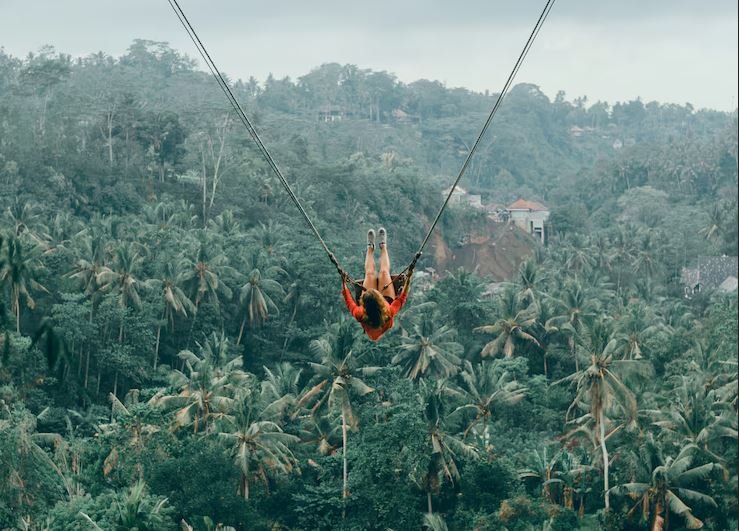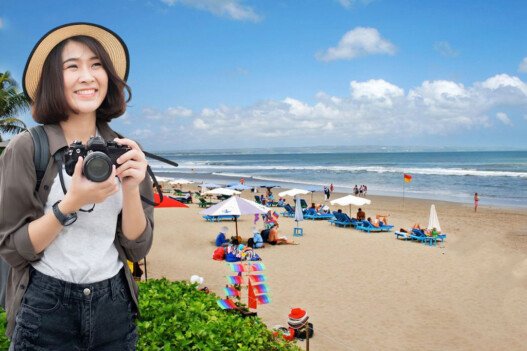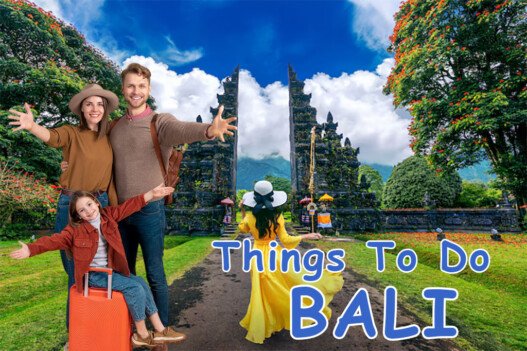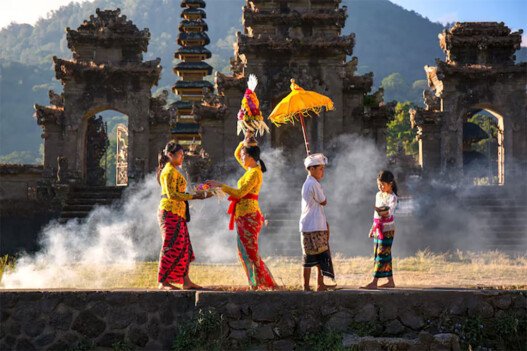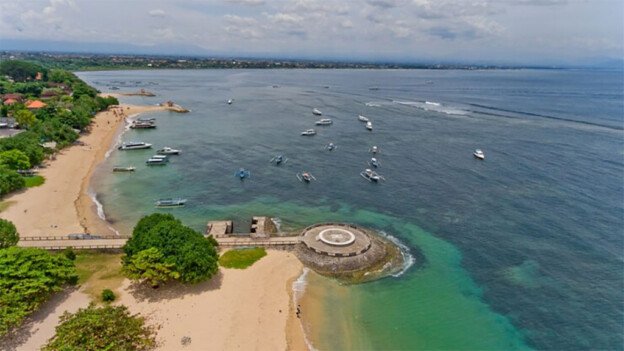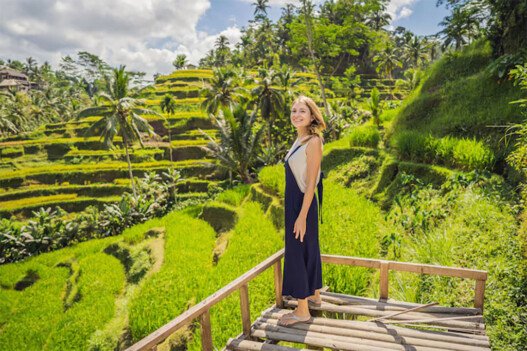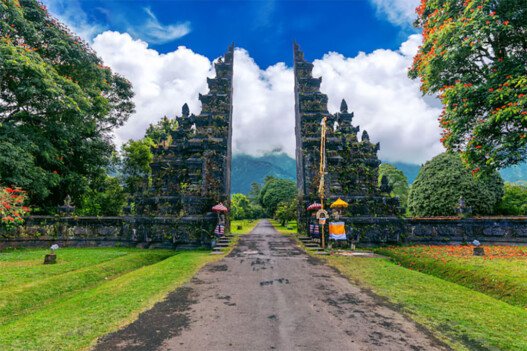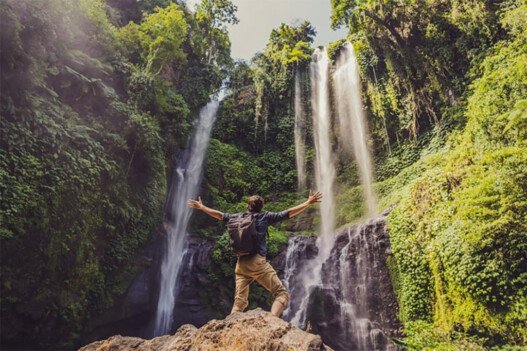The iconic Bali swing has become synonymous with Instagram-worthy travel photography, capturing the hearts of millions with its ethereal blend of adventure and tropical paradise. These gravity-defying moments, suspended high above emerald jungles and cascading rice terraces, represent more than just a photo opportunity—they’re a gateway to experiencing Bali’s natural magnificence from an entirely new perspective.
📸 The Art of the Perfect Swing Shot
Master Your Camera Settings
Creating that perfect swing photo requires more than just luck and a good location. Understanding your camera settings is crucial for capturing sharp, well-exposed images that truly showcase the magic of the moment.
Shutter Speed is King The most critical setting for swing photography is shutter speed. Aim for 1/250th of a second or faster to freeze the motion and eliminate blur. If you’re shooting in bright daylight, you can push this even higher to 1/500th for ultra-sharp results. Remember, a blurry swing photo loses all its impact—clarity is everything.
Aperture for Depth Use an aperture between f/8 and f/11 to ensure both the subject and the stunning background remain in focus. While a shallow depth of field might work for portraits, swing photography demands that viewers see the full scope of the landscape that makes Bali so breathtaking.
ISO Considerations Keep your ISO as low as possible (100-400) to maintain image quality. The tropical sun provides ample light during golden hour and midday shooting, so high ISO values are rarely necessary and will only introduce unwanted grain.
Timing is Everything
Golden Hour Magic The period 30 minutes before and after sunrise or sunset provides the most flattering light for swing photography. During these times, the harsh shadows disappear, and everything is bathed in a warm, ethereal glow that makes skin tones appear radiant and the landscape dreamy.
Midday Alternatives If golden hour isn’t possible, slightly overcast conditions during midday can work beautifully. The clouds act as a natural diffuser, creating even lighting that eliminates harsh shadows while maintaining vibrant colors in the landscape.
Composition Techniques That Work
Rule of Thirds with a Twist Position the swing and subject in the lower third of the frame, allowing the magnificent Bali landscape to dominate the upper two-thirds. This creates a sense of scale and emphasizes the height and adventure of the experience.
Leading Lines Utilize natural elements like mountain ridges, river valleys, or rows of palm trees to create leading lines that draw the viewer’s eye toward the swing. These elements add depth and guide attention to your focal point.
Framing Elements Incorporate overhanging branches, rock formations, or architectural elements from the swing platform to create natural frames around your subject. This technique adds layers to your composition and creates a more immersive viewing experience.
🏞️ Top Bali Swing Locations
Bali Swing Ubud – The Original Icon
Located in the heart of Ubud’s jungle, Bali Swing remains the most famous and recognizable swing destination on the island. This location offers multiple swing heights, from beginner-friendly options to heart-stopping extreme swings that soar 78 meters above the ground.
What Makes It Special:
- Panoramic views of virgin jungle canopy
- Professional photography services included
- Multiple swing options for different comfort levels
- Additional attractions like the “Nest” photo spots
Best Photo Opportunities: The classic shot features the swinger silhouetted against layers of green jungle with distant volcanic peaks. Early morning visits offer the best lighting and fewer crowds.
Wanagiri Hidden Hills – Double the Drama
This location offers unique twin swings that allow couples or friends to swing simultaneously, creating dynamic duo shots that are perfect for social media. The backdrop features the stunning Lake Buyan and Lake Tamblingan.
Unique Features:
- Twin swings for couple photos
- Breathtaking lake views
- Hand-carved Balinese-style swing seats
- Multiple photo spots beyond just swings
Photography Tips: The twin lakes create a stunning reflection effect during calm weather. Shoot during early morning for mirror-like water surfaces that double the visual impact.
Sekumpul Swing – Waterfall Wonder
Hidden near the famous Sekumpul waterfalls, this swing offers a completely different backdrop from the typical jungle or rice terrace views. The sound of cascading water adds an extra sensory element to the experience.
Why It’s Special:
- Waterfall backdrop creates unique photo opportunities
- Less crowded than mainstream locations
- Adventure hiking required to reach the spot
- Natural pools for additional photo opportunities
Aling-Aling Twin Swings – The Adventure Seeker’s Choice
Located near the Aling-Aling waterfall, these swings offer one of the most adventurous experiences available. The approach requires a moderate hike, but the payoff is spectacular views and fewer tourists.
Adventure Elements:
- Hiking trail adds to the experience
- Multiple waterfall viewpoints
- Natural swimming holes nearby
- Authentic jungle atmosphere
Tegallalang Rice Terraces Swing – Cultural Immersion
This location combines the swing experience with Bali’s iconic rice terraces, offering a perfect blend of adventure and cultural landscape photography.
Cultural Significance:
- UNESCO-recognized rice terrace system
- Traditional Balinese agricultural practices visible
- Best visited during rice growing season (October-March)
- Local warung (cafes) offer authentic Balinese cuisine
🎨 Styling and Preparation Tips
Wardrobe Selection
Flowing Fabrics Work Best Choose clothing that moves beautifully in the wind. Flowing dresses, lightweight scarves, and loose-fitting tops create dynamic movement that adds energy to your photos. Avoid tight-fitting clothes that don’t show movement.
Color Coordination Earth tones, pastels, and jewel tones photograph beautifully against Bali’s green landscapes. Avoid busy patterns that compete with the natural beauty of the background. White and cream create an ethereal look, while deep jewel tones provide striking contrast.
Practical Considerations Ensure your outfit is appropriate for the activity—no revealing clothing that might cause wardrobe malfunctions during the swing. Comfortable shoes with good grip are essential for navigating potentially slippery platforms.
Hair and Makeup
Wind-Resistant Styling The wind generated by swinging will affect your hair, so plan accordingly. Loose waves often look more natural than perfectly styled hair when caught by the wind. Consider braids or loose ponytails for more controlled movement.
Natural Makeup Approach Heavy makeup can look overdone in natural lighting and may smudge during the adventure. Opt for a natural look with waterproof mascara and a light, dewy foundation that will look fresh in photos.
Props and Accessories
Scarves and Flowing Elements Lightweight scarves, ribbons, or fabric pieces can add dramatic flair to your photos. These elements catch the wind and create beautiful movement that enhances the sense of flight and freedom.
Flowers and Natural Elements Fresh tropical flowers in your hair or carried as a bouquet can add a romantic, tropical touch that complements the natural setting. Plumeria, hibiscus, and orchids are readily available and photograph beautifully.
⚠️ Safety First – Essential Guidelines
Choosing Reputable Operators
Research and Reviews Always research swing operators thoroughly before visiting. Read recent reviews, check their safety record, and ensure they have proper insurance and safety equipment. Reputable operators will be transparent about their safety measures.
Equipment Inspection Upon arrival, inspect the swing equipment yourself. Look for signs of wear, proper maintenance, and quality construction. The rope, harness, and attachment points should all appear sturdy and well-maintained.
Physical Preparation
Health Considerations Swinging requires basic physical fitness and balance. If you have heart conditions, back problems, or pregnancy, consult with medical professionals before participating. Be honest about your physical limitations.
Mental Preparation The height and speed can be intimidating for some people. Take time to mentally prepare and don’t feel pressured to use the highest swing if you’re not comfortable. There’s no shame in choosing a lower, more manageable option.
Weather Awareness
Avoid Dangerous Conditions Never swing during thunderstorms, high winds, or heavy rain. These conditions make the activity extremely dangerous and will also result in poor photo quality.
Optimal Weather Windows The best conditions are calm, clear days with light winds. Check weather forecasts and be prepared to reschedule if conditions aren’t suitable.
📱 Technical Photography Tips
Equipment Recommendations
Camera vs. Smartphone While smartphones can capture decent swing photos, a DSLR or mirrorless camera will provide better image quality, especially in challenging lighting conditions. The faster autofocus and higher burst rates of dedicated cameras are particularly beneficial for action shots.
Lens Selection A wide-angle lens (14-35mm) is ideal for capturing both the subject and the expansive landscape. If you’re shooting from a distance with a telephoto lens, ensure your shutter speed is fast enough to prevent camera shake.
Advanced Techniques
Burst Mode Mastery Use continuous shooting mode to capture multiple frames during each swing. This increases your chances of getting the perfect expression and swing position. Modern cameras can shoot 10+ frames per second, giving you plenty of options.
Focus Tracking Use your camera’s continuous autofocus (AI Servo/AF-C) mode to track the moving subject. This ensures sharp focus throughout the swing’s arc, even as the distance between camera and subject changes.
Exposure Bracketing The high contrast between bright sky and darker jungle can challenge any camera’s dynamic range. Consider bracketing exposures or shooting in RAW format for maximum post-processing flexibility.
Post-Processing Magic
Color Enhancement Bali’s natural colors are already stunning, but subtle enhancement can make them pop. Increase vibrance (not saturation) to make greens more lush and skies more dramatic without creating an unnatural look.
Highlight and Shadow Recovery Use shadow lifting and highlight recovery to balance the exposure and reveal details in both the bright sky and darker landscape elements.
Sharpening and Clarity Apply appropriate sharpening to make the image crisp and detailed. A touch of clarity can add punch to the landscape elements without over-processing.
🌅 Planning Your Perfect Swing Day
Timing Strategies
Multiple Location Days Consider visiting multiple swing locations in a single day if they’re relatively close together. Start early to maximize golden hour opportunities at different locations.
Weekday Advantages Weekdays typically offer smaller crowds and more relaxed photography sessions. If your schedule allows, avoid weekends and Indonesian holidays for the best experience.
Logistics and Transportation
Transportation Options Rent a scooter for maximum flexibility, hire a driver for convenience, or join organized tours for hassle-free experiences. Each option has advantages depending on your comfort level and group size.
Time Allocation Allow at least 2-3 hours per location to account for waiting times, multiple photo attempts, and enjoying the experience without feeling rushed.
Budget Considerations
Entry Fees and Extras Swing locations typically charge entry fees ranging from 100,000 to 350,000 IDR. Professional photography services, if available, cost extra but often provide higher quality results than self-photography.
Hidden Costs Factor in transportation, meals, and optional extras like traditional costume rentals or additional photo props that some locations offer.
🤝 Cultural Sensitivity and Respect
Respecting Local Communities
Environmental Responsibility These swing locations exist within local communities and ecosystems. Respect the environment by not littering, staying on designated paths, and following all posted guidelines.
Supporting Local Economy Choose locally-owned swing operations when possible, eat at local warungs, and purchase souvenirs from local artisans to ensure your tourism dollars benefit the community.
Cultural Awareness
Appropriate Behavior Remember that you’re a guest in Bali. Dress appropriately, be respectful to staff and other visitors, and be mindful of local customs and traditions.
Photography Etiquette Ask permission before photographing local people and be respectful of others trying to enjoy their own swing experience.
🎯 Making Your Photos Stand Out
Creative Angles and Perspectives
Vary Your Shots Don’t just shoot from the standard platform position. Explore different angles—shoot from below looking up, from the side to show the swing’s arc, or from above if elevated positions are available.
Include Context While close-up shots are beautiful, also capture wide shots that show the full scope of the location and the swing’s relationship to the landscape.
Storytelling Through Photography
Capture Emotions The best swing photos capture genuine emotion—joy, excitement, freedom, or even nervous anticipation. Encourage natural expressions rather than forced smiles.
Document the Journey Take photos of the entire experience: the approach, preparation, the swing itself, and the aftermath. This creates a complete story of your adventure.
🌟 Final Thoughts
The perfect Bali swing photo is about more than technical perfection—it’s about capturing a moment of pure joy and freedom against one of the world’s most beautiful backdrops. While planning and preparation are important, don’t let the pursuit of the perfect shot overshadow the experience itself.
Remember that each swing location offers its own unique character and photographic opportunities. Whether you’re drawn to the jungle canopies of Ubud, the twin lakes of Wanagiri, or the cultural landscapes of Tegallalang, each location provides a different perspective on Bali’s incredible natural beauty.
The most important element in any great swing photo isn’t the camera settings or the perfect timing—it’s the genuine emotion and sense of adventure that comes from embracing the experience fully. When you combine that authentic joy with proper preparation and technique, you’ll create images that don’t just look beautiful, but truly capture the magic of your Bali adventure.
So take that leap, embrace the swing, and let Bali’s natural beauty provide the perfect backdrop for memories that will last a lifetime. The perfect photo is just waiting for you to create it.

